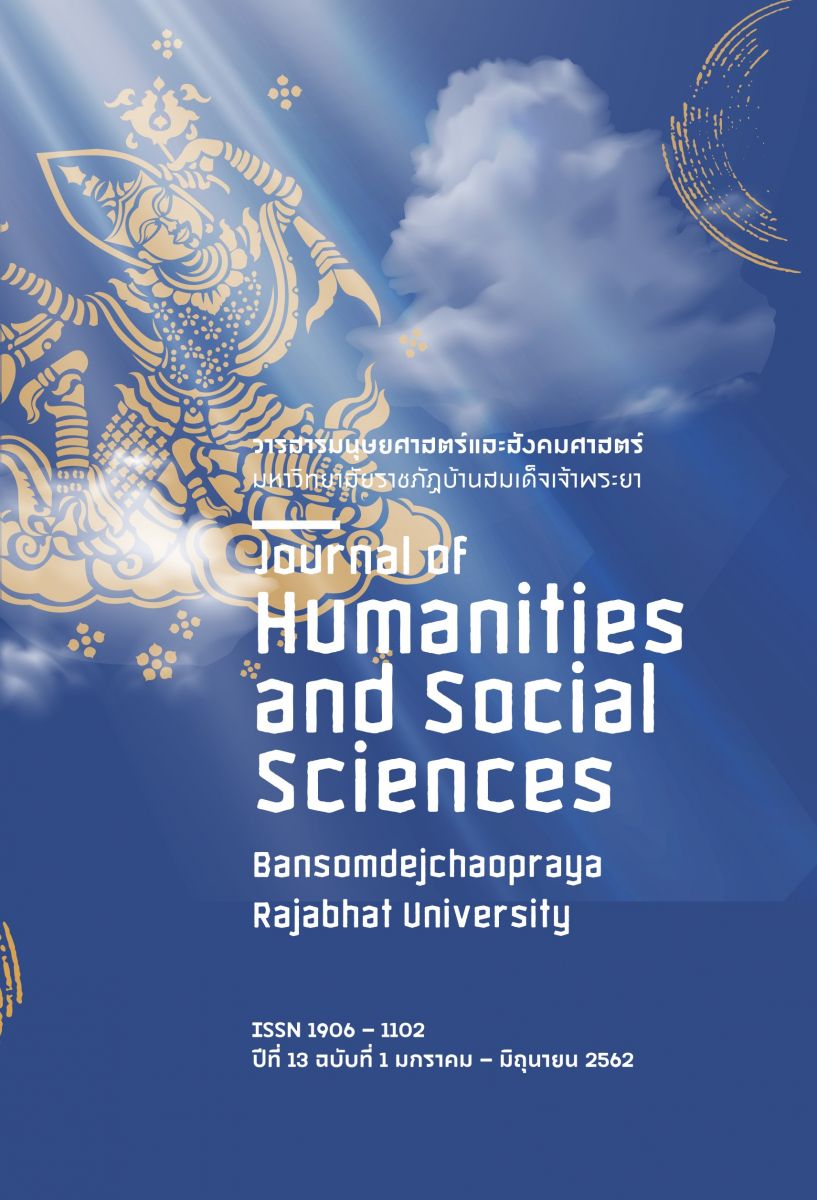รือบะ: ซอสามสายแห่งชายแดนใต้
คำสำคัญ:
รือบะ, ฆือบะ, เรบับ, มะโย่ง, ดนตรีพื้นบ้านภาคใต้ตอนล่างบทคัดย่อ
รือบะ ฆือบะ เรบับ หรือเรอบับ เป็นเครื่องดนตรีประเภทเครื่องสี คันชักอิสระ ได้รับอิทธิพลจากวัฒนธรรมดนตรีของชาวอาหรับ เรียกว่า Kamanche และกระจายในเอเชียตะวันออกเฉียงใต้ พบในประเทศไทย มาเลเซีย อินโดนีเซีย และกัมพูชา หากแต่มีรูปร่าง และจำนวนสายแตกต่างกัน สำหรับรือบะในประเทศไทยนั้นมี 3 สาย ใช้บรรเลงประกอบการแสดงมะโย่ง โดยเฉพาะ 3 จังหวัดชายแดนภาคใต้ ส่วนประกอบของรือบะ ประกอบด้วย 1) คันทวนส่วนบนหรือบูงอลานะ 2) คันทวนหรือตูแลบาแก 3) ลูกบิด หรือปูละตาลี 4) กะโหลกซอ หรือปาแปปูงง 5) หน้าซอ 6) เท้าซอ หรือกากี 7) ถ่วง หรือซูซู 8) คันชัก หรือปาแตแกแซ 9) สายซอ หรือตาลีปูซะ 10) รัดอก และ 11) หย่อง หรือปาจ๊ะ ลักษณะการนั่งบรรเลงรือบะนั้นจะวางค่อนไปทางซ้ายด้านหน้าของผู้บรรเลงในลักษณะตั้งฉากกับพื้น จับคันทวนด้วยมือซ้าย และจับคันชักด้วยมือขวา การเทียบเสียงรือบะนั้นเทียบเสียงเป็นคู่ 4 สายในตรงกับเสียงโดสูง (C) สายกลางเสียงซอล (G) สายนอกเสียงเร (D) โดยมักเทียบจากเสียงร้องของผู้แสดงมะโย่งเพื่อให้ขับร้องได้สะดวก ด้านการสืบทอดการบรรเลงรือบะ พบว่า ใช้วิธีการเรียนรู้ด้วยตนเองในลักษณะครูพักลักจำ ปัจจุบันยังไม่ปรากฏว่ามีหลักสูตรการสอนอย่างเป็นระบบ ด้านโอกาสการบรรเลงพบว่าการแสดงเพื่อความบันเทิงนั้นลดน้อยลง หากแต่ยังมีโอกาสการแสดงในลักษณะที่เกี่ยวข้องกับพิธีกรรม เช่น พิธีไหว้ครู พิธีแก้บน ดังนั้นหน่วยงานทั้งภาครัฐ เอกชน ตลอดจนภาคีเครือข่ายชุมชนสังคมควรเร่งการถอดองค์ความรู้เกี่ยวกับรือบะก่อนจะสูญหายในอนาคตอันใกล้
เอกสารอ้างอิง
จิตติมา นาคีเภท. (2556). โนรา : นาฏยศิลปะในฐานะเป็นพันธกิจอันศักดิ์สิทธิ์. วารสารมนุษยศาสตร์, 20 (2), 21-39.
เซ็ง สุหลง. ชาวบ้านตำบลลิดล อำเภอเมือง จังหวัดยะลา. (สัมภาษณ์, 24 พฤษภาคม 2560).
ดะห์รี แอมอง. ชาวบ้านตำบลพร่อน อำเภอเมือง จังหวัดยะลา. (สัมภาษณ์, 2 เมษายน 2560).
ต่วนมะ มือและ. ชาวบ้านตำบลธารคีรี อำเภอสะบ้าย้อย จังหวัดสงขลา. (สัมภาษณ์, 24 พฤษภาคม 2560).
ต้นตาลโตนด. (2558). ค้นเมื่อวันที่ 4 เมษายน 2561. จาก http://tntaltond.blogspot.com
บุษกร บิณฑสันต์. (2554). ดนตรีภาคใต้ : ศิลปิน การถ่ายทอดความรู้ พิธีกรรมและความเชื่อ. กรุงเทพฯ : สำนักพิมพ์แห่งจุฬาลงกรณ์มหาวิทยาลัย.
ภิญโญ เวชโช. (2556). มะโย่ง : นาฏละครมลายู. ยะลา : มหาวิทยาลัยราชภัฏยะลา.
มอฮาหมัดซอรี อาบู. ชาวบ้านตำบลแม่ลาน อำเภอแม่ลาน จังหวัดปัตตานี. (สัมภาษณ์, 24 พฤษภาคม 2560).
ลำใย ไชยสาลี. (2542). การศึกษาเครื่องดนตรีพื้นบ้านภาคใต้. วิทยานิพนธ์ศิลปศาสตรมหาบัณฑิต สาขาวิชาไทยคดีศึกษา บัณฑิตวิทยาลัยมหาวิทยาลัยทักษิณ.
วันชัย เอื้อจิตรเมศ. (2560). ท่านั่งการบรรเลงรือบะ. [ภาพถ่าย]. นครศรีธรรมราช : สาขาวิชาดนตรี มหาวิทยาลัยราชภัฏนครศรีธรรมราช.
วันชัย เอื้อจิตรเมศ. (2560). ปาแตแกแซ หรือ คันชัก. [ภาพถ่าย]. นครศรีธรรมราช : สาขาวิชาดนตรี มหาวิทยาลัยราชภัฏนครศรีธรรมราช.
วันชัย เอื้อจิตรเมศ. (2560). ปาแปปูงง. [ภาพถ่าย]. นครศรีธรรมราช : สาขาวิชาดนตรี มหาวิทยาลัยราชภัฏนครศรีธรรมราช.
วันชัย เอื้อจิตรเมศ. (2560). วิธีการจับคันชัก. [ภาพถ่าย]. นครศรีธรรมราช : สาขาวิชาดนตรี มหาวิทยาลัยราชภัฏนครศรีธรรมราช.
วันชัย เอื้อจิตรเมศ. (2560). วิธีการจับคันทวน. [ภาพถ่าย]. นครศรีธรรมราช : สาขาวิชาดนตรี มหาวิทยาลัยราชภัฏนครศรีธรรมราช.
วันชัย เอื้อจิตรเมศ. (2560). วิธีการจับลูกบิดเพื่อเทียบเสียง. [ภาพถ่าย]. นครศรีธรรมราช : สาขาวิชาดนตรี มหาวิทยาลัยราชภัฏนครศรีธรรมราช.
วันชัย เอื้อจิตรเมศ. (2560). ส่วนประกอบของรือบะ. [ภาพถ่าย]. นครศรีธรรมราช : สาขาวิชาดนตรี มหาวิทยาลัยราชภัฏนครศรีธรรมราช.
วาที ทรัพย์สิน และทัศนียา วิศพันธุ์. (2551). ระบำพื้นบ้านจังหวัดปัตตานี ที่มีรากมาจากดนตรีรองเง็ง. ว.รูสมิแล. 29 (1), 42-45.
สำนักงานวัฒนธรรมจังหวัดปัตตานี. (2551). การมีส่วนร่วมของเครือข่ายวัฒนธรรมและชุมชน ในการบริหารจัดการวัฒนธรรม : กรณีศึกษาการแสดงมะโย่ง อำเภอเมือง จังหวัดปัตตานี. ปัตตานี : สำนักงานวัฒนธรรมจังหวัดปัตตานี.
แสง มนวิทูร. (2541). นาฏยศาสตร์. (พิมพ์ครั้งที่ 2). กรุงเทพฯ : กองวรรณกรรมและประวัติศาสตร์ กรมศิลปากร.
Kaemmer, J.E. (1993). Music in Human Life : Anthropological Perspectives on Music. Texas : University of Texas Press.
Olomi, M. (2015). Kamanche, the Bowed String Instument of the Orient. International Journal of Arts and Commerce. 4 (1), 92-101. From: https://ijac.org.uk/images/frontImages/gallery/Vol._4_No._1/10._92-101.pdf
Rahimidim, Z. & RS.Umar.Sutung. (2011). Makyung the Mystical Heritage of Malaysia. Kuala Lumpur : MPH Group Printing.
ดาวน์โหลด
เผยแพร่แล้ว
รูปแบบการอ้างอิง
ฉบับ
ประเภทบทความ
สัญญาอนุญาต
ลิขสิทธิ์ (c) 2019 คณะมนุษยศาสตร์และสังคมศาสตร์ มหาวิทยาลัยราชภัฏบ้านสมเด็จเจ้าพระยา

อนุญาตภายใต้เงื่อนไข Creative Commons Attribution-NonCommercial-NoDerivatives 4.0 International License.




